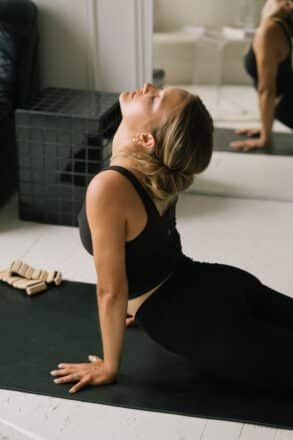Understanding and communicating the risks and preventative measures surrounding falls and fractures in older adults is essential, which is why “Preventing Falls and Fractures in Older Adults through Regular Exercise” is of significant importance. This piece sheds light on a few stark facts: over a quarter of those over 65 years old fall each year, various ailments can disrupt balance, and certain medications come with side effects that increase the likelihood of a fall.
Therewith, it also explains how age-related muscle mass loss, balance issues, and abrupt drops in blood pressure only exacerbate the problem. However, it’s not all doom and gloom as preventative steps like regular exercise, home safety improvements, medication management, and regular vision checks contribute significantly toward fall prevention. Even if a fall takes place, there are crucial steps that can help reduce injuries.
Similarly, maintaining healthy bones could mean the difference between a minor incident and a potential catastrophe, particularly for those battling osteoporosis. Thus, this piece aims to highlight that, equipped with awareness and action, the risk of serious falls and fractures can be substantially reduced.

Understanding the Risks of Falls and Fractures in Older Adults
In the journey of aging, one’s wellbeing can be seriously affected by the increased risks of falls and fractures. It’s common knowledge that the older we get, the more prone we become to such accidents. Nonetheless, knowledge about these risks does not only lie in understanding that they exist but requires comprehending why they appear, how to prevent them, and what to do when they occur.
Statistics on falls and fractures among seniors
You might be surprised to hear that more than one in four people aged 65 years or older fall each year. This makes it a prevalent issue to be addressed among older adults, especially considering that with age, the chances of falling and experiencing fall-related complications considerably increase.
Health complications from falls and fractures
Falls and fractures in older adults can lead to severe health problems, even permanent disability. Something as simple as a misstep can result in a hip fracture, causing a significant decline in an individual’s mobility, independence, and overall quality of life. Not only are these incidents physically damaging, but they can also have lasting psychological implications, such as a developed fear of falling that may inhibit the individual’s desire to be active.
How age, chronic conditions and medications augment fall risk
It’s also important to be aware that certain conditions, like diabetes, heart disease, thyroid, nerve, foot, or blood vessel problems, can adversely affect balance and inadvertently cause a fall. Additionally, certain medications can raise a person’s risk of falling by giving rise to side effects like disorientation or dizziness.
Elevating Risks: Sarcopenia, Imbalances and Medications
Recognizing the factors that elevate the risk of falls is a crucial step towards prevention. Some factors like sarcopenia, balance issues, and certain medications take a crucial toll on an individual’s risk of falling.
Explaining sarcopenia and its association with falls
One risk factor to note is sarcopenia, an age-related loss of muscle mass. As we age, our muscles naturally lose their strength and flexibility, leading to a reduced ability to balance and an increased likelihood of falling.
Balance and gait problems leading to fall risk
The way we walk, known as our gait, and our balance capabilities can become impaired as we get older. This progression not only leads to an increased risk of falling, but can also cause falls to happen more frequently. Even matters like a blood pressure drop upon standing can compound this risk.
How certain medicines impact risk of falls
Medications too play a significant role in fall risk. Drugs designed to treat sleep disorders, mood changes, hypertension, and many other conditions can have side effects like dizziness, disorientation, blurred vision or lowered blood pressure. These are all likely to increase the risk of a fall.
Importance of Regular Exercise in Fall Prevention
If you want to fend off the threat of falls and fractures, regular exercise is a fantastic place to start. This not only strengthens your body, but also improves balance and mobility, essential in preventing falls.
Benefits of regular physical activity for seniors
Regular physical activity has numerous benefits for seniors—not just in minimizing the risk of falls but also in improving overall health. It helps maintain healthy body weight, manage chronic illnesses, and enhance mental health and flexibility.
How exercise reduces fall risks
When it comes to fall prevention, exercise can play a pivotal role. It can enhance muscle strength, joint flexibility, and balance— all of which can aid in preventing falls. Whether it’s yoga, tai chi, or simple walking, routine physical activity is helpful in safeguarding you against falls.
Recommended exercises for older adults
While any movement is better than none, it’s best to go for exercises that can improve balance and coordination. This includes activities like tai chi, leg strengthening exercises, balance exercises, and endurance activities like walking or swimming. Before starting any new exercise regimen, remember to check with your healthcare provider first.
Preventive Strategies for Falls and Fractures
There’s a range of preventive measures to consider that can significantly reduce the risk of falls and fractures.
Overview of effective preventive measures
These range from staying physically active and maintaining overall health, to getting regular vision and hearing tests and learning the side effects of medications. Also, getting enough sleep, limiting alcohol intake, standing up slowly, and using assistive devices where needed can also help prevent falls.
Role of medication management
An essential part of fall prevention is aware medication management. If you are taking medicines that affect your cognitive or physical functions, consider discussing it with your healthcare provider. They can help you weigh the medication’s benefits against its risk for increasing falls and choose the safest option for you.
Importance of regular vision checks
Your vision plays a vital role in maintaining balance and coordination. Regular vision checks can help detect vision problems early and prevent unexpected falls and injuries. Always wear prescribed glasses or contact lenses when needed to ensure clear and proper vision.

Creating a Safer Home Environment
Making some simple modifications to your home can go a long way in preventing falls and fractures.
How home modifications can prevent falls
There’s a wide array of home modifications to consider that can help prevent falls. These adjustments can range from adequate lighting, removing rugs and clutter, installing grab bars and railings to investing in non-slip mats for certain areas, such as bathrooms and kitchens.
Suggestive adjustments to make homes safer
Start by ensuring your home has ample lighting, particularly in stairways and bathrooms. Make the floor free of clutter and add secure, non-slip rugs. You can also consider installing grab bars in your bathrooms and handrails on all stairs. Pay special attention to the kitchen and arrange frequently used items in easy-to-reach places to avoid the need for ladders or stools.
Importance of using assistive devices
Assistive devices like canes or walkers can be indispensable tools for individuals with balance problems or who feel unsteady when walking. It’s best to discuss the need for an assistive device with your healthcare provider, as using an inappropriate device or using it incorrectly can increase the risk of falling.
Keeping Overall Health on Check
By maintaining your overall health, you’re strengthening your ability to prevent falls.
Importance of regular health check-ups
Regular health check-ups are invaluable—they help identify potential health issues before they become severe and affect your balance or increase your risk of falls. Make sure to discuss any health concerns with your healthcare provider, including any falls you’ve experienced, even if they didn’t cause injury.
Effect of sleep and limitations on alcohol
Getting enough sleep is essential—it helps keep your body and mind sharp and reduces the risk of fatigue-related falls. Limiting alcohol consumption is also beneficial because alcohol can interfere with balance and reflexes, increasing the risk of falls.
Significance of slowly standing up to prevent falls
Blood pressure can drop rapidly when you stand up too quickly, leading to dizziness and a higher chance of falling. To prevent this, always take your time when transitioning from a sitting or lying position to standing.

Steps to Take After a Fall
Unfortunately, falls can still occur even with every preventive measure in place. However, knowing what steps to take afterward can make a significant difference.
Staying calm and assessing injuries
Should you experience a fall, remember to stay calm—panicking can often exacerbate the situation. Take some time to assess your situation and check for any injuries before making any sudden movement.
Safe ways to get up after a fall
When rising after a fall, it’s crucial to do it in a safe and controlled way. Start by positioning yourself in a comfortable, seated position. Next, use a sturdy piece of furniture for support and slowly work yourself up. Avoid rushing the process and take it slow and steady.
When and how to call for help
If you’re unable to get up on your own or if you’re feeling considerable pain, immediately call for help. Even if there are no visible injuries after a fall, seek medical attention as internal injuries can be concealed sometimes.
Nourishing for Bone Health
Maintaining bone health is essential—sturdy bones can help prevent serious injuries in case of a fall.
Role of sturdy bones in fall injury prevention
Bones are the supporting framework of our body. Healthy, sturdy bones can withstand impacts better, which means they’re less likely to fracture in a fall. Thus, having good bone health can go a long way in mitigating the damage caused by falls.
Importance of sufficient calcium and vitamin D intake
Your bones need sufficient levels of calcium and vitamin D to maintain their strength. Good food sources of calcium include dairy products, green leafy vegetables, and fortified foods. Vitamin D, on the other hand, is produced when your skin gets exposed to sunlight. You can also get it from food sources like fatty fish and fortified dairy products.
Significance of physical activity and maintaining a healthy weight for bone health
Being physically active not only strengthens your muscles but also your bones. Weight-bearing exercises like walking, jogging, or lifting weights are particularly beneficial for bone health. Moreover, maintaining a healthy weight is also critical to avoid putting unnecessary load on your bones and joints.
Understanding Osteoporosis and Fall Risks
Osteoporosis is a condition that needs earnest consideration when we talk about falls and fractures. It’s a disease that progressively weakens bones, making even a minor fall potentially dangerous.
Defining osteoporosis and its effects on bone strength
Osteoporosis is a medical condition characterized by a decrease in bone density and strength. Over time, this can lead to an increased risk of fractures, which is why it’s often dubbed as a ‘silent disease’— you may not realize you have it until a bone breaks.
Why osteoporosis makes falls more dangerous
So why does osteoporosis make falls more dangerous? Simply because it weakens the bones, making them more prone to fractures. Hence, even a seemingly harmless trip or fall can lead to a serious bone injury like a hip fracture in individuals with osteoporosis.
Managing osteoporosis to prevent serious fall injuries
Successful management of osteoporosis can mitigate significant fall injuries. This involves a multi-pronged approach comprising of a balanced diet rich in calcium and vitamin D, regular physical activity, cessation of smoking, and limiting alcohol consumption. Specific osteoporosis medications might be prescribed by your medical provider, depending on the severity of the condition and its progression.
Conclusion: Unifying Exercise and Overall Health for Fall Prevention
In conclusion, the keys to successful fall prevention are regular exercise, good nutrition, and overall health maintenance.
Recap of the importance of regular exercise
Regular exercise builds strength, increases flexibility, sharpens balance and coordination, and optimizes overall health— all of which are effective ways of reducing the risks of falls and fractures.
How maintaining overall health contributes to fall prevention
Maintaining your overall health through regular health check-ups, adequate sleep, and a balanced diet is equally critical. This will ensure all your bodily systems are functioning optimally and thus promote balance and prevent falls.
Final thoughts on the holistic approach to prevent falls in older adults
fall prevention is a holistic strategy that emphasizes regular exercise, maintaining overall health, creating a safer home environment, and proper management of medications and chronic conditions. Understanding these preventive measures and implementing them into your daily routine can potentially spare you from the risk of falls and, consequently, from serious injuries. Stay vigilant, stay active, and stay safe.
